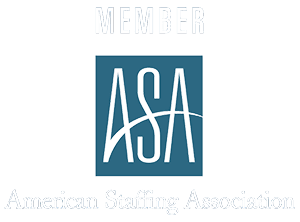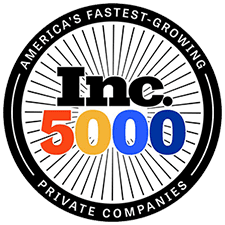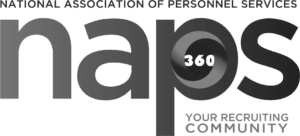2025 has brought major changes and challenges to the staffing industry. As the industry goes through a transformative phase, a new set of challenges is emerging. The competition for high-quality candidates is at an all-time high level, and it is driven by skill shortages in high-demand industries like tech, healthcare, and engineering. In fact, McKinsey reports that 87 percent of companies have a skill gap in their operations.¹
But that’s not all, the average candidate’s needs have evolved with 37 percent of U.S. job seekers being interested in a fully remote position, while 60 percent would like a hybrid role.² This growing embrace of remote has expanded talent pools and intensified global competition.
Relying on job boards or manual resume screening doesn’t cut it anymore. You need to keep up with the next big things in staffing if you don’t want to fall behind your competition. Here are the trends shaping the staffing industry this year.
1. Leverage Artificial Intelligence in Recruitment
Transform your recruitment process with AI-powered tools that streamline candidate sourcing, enhance matching accuracy, and boost productivity through personalized communications.
Current State
Many staffing agencies are integrating AI adoption into operations. These AI tools simplify candidate sourcing and matching processes. For example, tools like Sovren can analyze resumes at scale, extracting relevant skills, experiences, and qualifications within seconds. AI tools let you place faster, match job candidates better, and reduce operational costs.
What’s New
AI keeps advancing and it’s getting better daily. The emergence of generative AI (GenAI) is changing candidate engagement by creating personalized, responsive communications that improve the candidate experience and productivity.
The gains provided by AI have significantly risen with recent data showing that those who have adopted GenAI are reaping a 40 percent increase in productivity.³ In addition, AI can now predict candidate success rates in specific roles by analyzing patterns in skills and experience.
How to Implement
Start by integrating AI-powered tools like an applicant tracking system (ATS) equipped with advanced resume parsing and candidate ranking capabilities to save time, and resources. Use GenAI tools to create personalized candidate communications, such as tailored outreach emails, interview feedback summaries, and role-specific candidate engagement campaigns.
Tools Needed
Use tools like Jobdeck for AI-powered job postings. It uses AI and automation for marketing campaigns, assessing candidates, and workflow management.
Platforms like Calendly use AI to help candidates self-schedule interviews, reducing back-and-forth emails. GenAI tools like Jasper AI can be used to create personalized emails, job descriptions, and even interview questions.
Transforming Your Operations
Integrating GenAI into your recruitment process enhances candidate engagement, improves response rates, and creates a seamless experience for both candidates and recruiters. This not only reduces time-to-fill but also builds stronger relationships with top talent.
When you automate repetitive tasks, you save time and resources. Also, your recruiters get to focus on high-value tasks like talent and client acquisition.
2. Build Data-Driven Talent Pools
Create proactive talent pipelines using analytics and predictive insights to anticipate client needs and reduce time-to-fill for high-demand roles.
Current State
Staffing agencies handle a lot of data. And their database holds deeper insights that can spot growth opportunities immediately. Today’s firms use data analytics to create proactive pipelines for high-demand roles. In fact, talent acquisition teams with analytics are two times more likely to improve their recruiting efforts and three times more likely to realize cost reductions and efficiency gains.
These data-driven approaches help firms anticipate talent needs and reduce the scramble to find candidates for urgent requests. However, many firms remain reactive, focusing on immediate client demands rather than developing future-ready talent pools that ensure long-term success.
What’s New
Data can now be used to inform decision-making and measure performance. Advancements in predictive analytics and real-time labor market insights are transforming how staffing firms manage their talent pipelines.
With these tools, you can anticipate needs before they arise and stay one step ahead. AI-driven ATS systems have even made it better. Now, you can categorize talent pools based on skills, location, and industry trends.
Transforming Your Operations
Invest in tools that integrate labor market data with candidate databases, enabling recruiters to identify emerging trends and align their pipelines.
Showcase your expertise to passive candidates by sharing personalized content, such as skill-building resources, market updates, or tailored job opportunities, to keep them active in your talent pool. Use predictive analysis tools to identify gaps in your talent database and when you notice any gaps, that’s your cue to source for roles likely to be in demand.
Tools Needed
CRM tools with AI integration like Bullhorn CRM to find the best candidates from existing talent pools by matching keywords, skills, and experience. Predictive analysis tools like Eightfold.ai to assess the likelihood of candidate success in specific roles.
Transforming Your Operations
These data-driven talent pools will reduce the time it takes for you to source, match, and place a qualified candidate. In addition, a proactive candidate pipeline equips you to meet the urgent demands of your client regardless of complexity.
With predictive analytics and AI categorization, you can anticipate and address talent shortages in specialized fields like tech and healthcare before clients even realize the need.
3. Encourage Hybrid Work Models
Educating your clients on how to meet the evolving workforce expectations is critical. By offering flexible staffing solutions that balance remote and on-site work, that will help clients attract and retain top talent.
Current State
Hybrid work is becoming the standard for many industries, with clients increasingly seeking staffing solutions that support flexibility in both workforce location and scheduling. At the same time, candidates want job opportunities that offer a mix of remote and on-site work. Most candidates are seeking a choice that prioritizes work-life balance and autonomy.
What’s New
Hybrid work is a system that balances worker productivity and employee satisfaction with fewer downsides than a fully remote or fully in-office team. Technological advancements have made it easier. AI-powered scheduling tools and hybrid-first platforms now allow remote and in-office employees to coordinate seamlessly.
Related Reading: Navigating the Future of Staffing: Integrating Contract Staffing for Growth and Resilience
Transforming Your Operations
Use surveys or consulting tools to check if your clients are ready for hybrid work models, identifying gaps in policies, technology, or team management. Create workflows that cater to the preferences of hybrid work, with clear expectations for both remote and on-site work. Encourage clients and candidates to adopt hybrid work-enabling technologies for seamless communication and scheduling.
Technology Needed
Communication tools like Zoom, Microsoft Teams, and Workplace by Facebook for hybrid meeting management.
Instant messaging and team collaboration tools like Slack to bridge hybrid workforce management
Project management tools like Monday.com and Asana to schedule and assign tasks to the hybrid workforce.
Transform your staffing potential with Signature Back Office Solutions
Don’t let complex industry changes slow your growth. Partner with Signature Back Office Solutions to unlock your firm’s full potential. We provide the expertise and tools you need to grow confidently in today’s evolving market. Contact us today, and let’s build your competitive advantage together.
References
- “2024 B2B Marketing Benchmark | Download Annual Report.” 2024 B2B Marketing Benchmark | Download Annual Report, business.linkedin.com/marketing-solutions/b2b-benchmark/2024.
- “Data Driven Recruiting | LinkedIn Talent Solutions.” Data Driven Recruiting | LinkedIn Talent Solutions, business.linkedin.com/talent-solutions/resources/talent-strategy/data-driven-recruiting.
- “Mind the [Skills] Gap.” McKinsey & Company, 27 Jan. 2021, www.mckinsey.com/featured-insights/sustainable-inclusive-growth/charts/mind-the-skills-gap.





